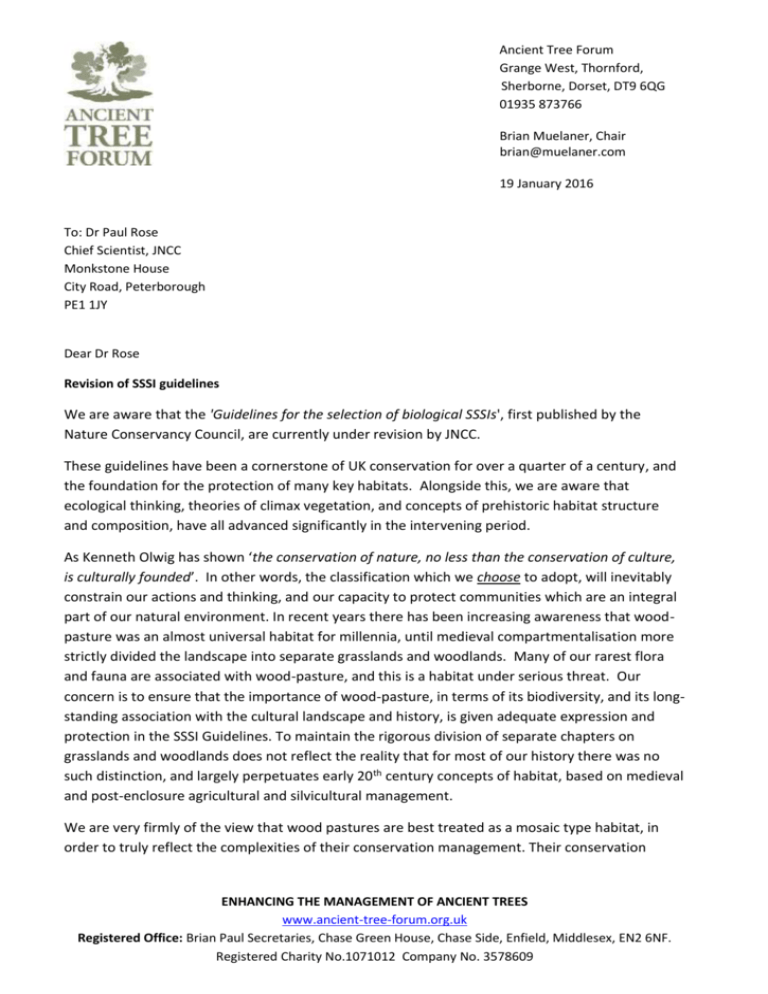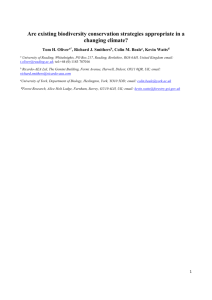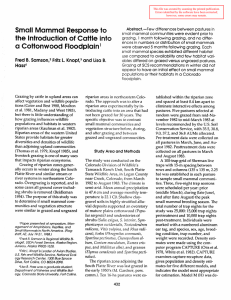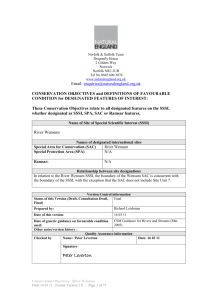ATF letter to JNCC re revision of SSSI guidelines January 2016
advertisement

Ancient Tree Forum Grange West, Thornford, Sherborne, Dorset, DT9 6QG 01935 873766 Brian Muelaner, Chair brian@muelaner.com 19 January 2016 To: Dr Paul Rose Chief Scientist, JNCC Monkstone House City Road, Peterborough PE1 1JY Dear Dr Rose Revision of SSSI guidelines We are aware that the 'Guidelines for the selection of biological SSSIs', first published by the Nature Conservancy Council, are currently under revision by JNCC. These guidelines have been a cornerstone of UK conservation for over a quarter of a century, and the foundation for the protection of many key habitats. Alongside this, we are aware that ecological thinking, theories of climax vegetation, and concepts of prehistoric habitat structure and composition, have all advanced significantly in the intervening period. As Kenneth Olwig has shown ‘the conservation of nature, no less than the conservation of culture, is culturally founded’. In other words, the classification which we choose to adopt, will inevitably constrain our actions and thinking, and our capacity to protect communities which are an integral part of our natural environment. In recent years there has been increasing awareness that woodpasture was an almost universal habitat for millennia, until medieval compartmentalisation more strictly divided the landscape into separate grasslands and woodlands. Many of our rarest flora and fauna are associated with wood-pasture, and this is a habitat under serious threat. Our concern is to ensure that the importance of wood-pasture, in terms of its biodiversity, and its longstanding association with the cultural landscape and history, is given adequate expression and protection in the SSSI Guidelines. To maintain the rigorous division of separate chapters on grasslands and woodlands does not reflect the reality that for most of our history there was no such distinction, and largely perpetuates early 20th century concepts of habitat, based on medieval and post-enclosure agricultural and silvicultural management. We are very firmly of the view that wood pastures are best treated as a mosaic type habitat, in order to truly reflect the complexities of their conservation management. Their conservation ENHANCING THE MANAGEMENT OF ANCIENT TREES www.ancient-tree-forum.org.uk Registered Office: Brian Paul Secretaries, Chase Green House, Chase Side, Enfield, Middlesex, EN2 6NF. Registered Charity No.1071012 Company No. 3578609 involves a unique combination of pasture and tree management. It is our contention that wood pastures – and former wood pastures - should not be just a subsection of woodland guidelines, and that other vegetation types should not be treated in isolation from trees, eg grassland or heathland, as our experience has been that land managed as grassland almost invariably results in damage to wood-pasture interests. We are writing therefore to enquire how current thinking, and the importance of wood-pasture, will be given adequate recognition within SSSI Guideline chapter headings as a result of the current revision. Yours sincerely Brian Muelaner Chair, Ancient Tree Forum ENHANCING THE MANAGEMENT OF ANCIENT TREES www.ancient-tree-forum.org.uk Registered Office: Brian Paul Secretaries, Chase Green House, Chase Side, Enfield, Middlesex, EN2 6NF. Registered Charity No.1071012 Company No. 3578609











